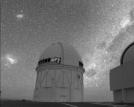Science with the Virtual Observatory
Terabytes of data are stored in archives
that need to be described, indexed and federated in a uniform way
to ensure their interoperability and a maximum scientific return.
Thanks to their proximity, their various stellar populations, and their nature of galactic systems,
the Magellanic Clouds are ideal testbeds for the
Virtual Observatory.
-
At CDS
Partly supported by the European ASTROVIRTEL
program, I cross-matched the near-infrared DENIS
and 2MASS
point sources towards the Magellanic Clouds. The cross-correlation procedure
is being extended to other wavelength ranges: far-infrared, optical,
X-ray...
The aim is to build a reference catalogue of stars based on multiwavelength
cross-identification of several astronomical catalogues. It provides
an unprecedented basis for the study of stellar populations in the Magellanic
Clouds. More about this Master Catalogue of stars towards the Magellanic
Clouds (MC2) can be found at http://vizier.u-strasbg.fr/MC2/.
The Magellanic Clouds
are two galaxies located in the Southern Skies. They look like two hazy
patches of light to the naked eye and have no counterparts in the Northern
Hemisphere, which make them so astonishing to the Northern observer...
Just click on the right-side image to see them better!
|

|
-
At ESO
I am calibrating the properties of massive stars in the near-infrared on Galactic structure purposes.
Because they are intrisically very luminous, they have been
traced in nearby galaxies to be used as distance indicators. They play a
key role in the understanding of the cosmological evolution of the Universe:
the better their stellar properties are understood, the better their contribution
to the luminosity of high-redshifted galaxies can be estimated.
Furthermore, massive stars are an essential part of the galactic evolution process
though their lifetime (107yr) is negligible at a galactic timescale.
Through their stellar winds during lifetime and at death when they explode
into supernovae, they release not only a lot of kinetic energy into the
interstellar medium but also the heaviest elements of the Galaxy which are
created deep in their center, contributing to its enrichment in metallicity.
Massive stars are often found in HII regions where they ionize the surrounding gas, creating
beautiful starforming nebulae.
Pictures of such regions may be found
here
and there.
I started a study on such HII regions in the Large Magellanic Cloud
to gain insight in the local star formation history.

